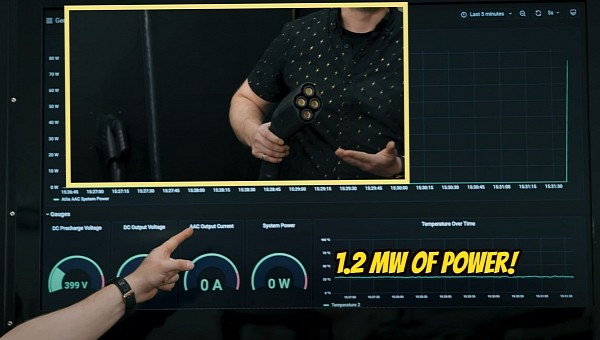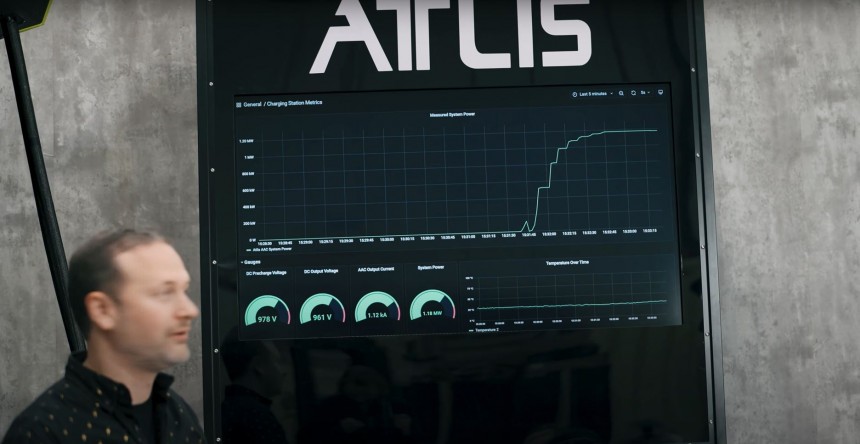The much-hyped Tesla Semi started being delivered to PepsiCo after a three-year delay. But now, the marque is in another pickle because almost three months have passed since the first semitrailer trucks were sent out, and nobody got to see the company’s V4 1,000-kW DC charger in action. Atlis seized the opportunity and just presented its own MegaCharger, albeit it might end up with a different name.
Atlis is not a common name for all the electric vehicle (EV) enthusiasts out there. That’s why we believe that your memory might use a friendly jolt. The Mesa-based company made headlines in 2021 when it announced that it’s going to build the XT, a pickup truck capable of towing 35,000 lb (15,876 kg) and doing 500 mi (805 km) on a single charge. The brand also claimed the tradespeople-oriented XT would have multiple drive-by-wire systems and be capable of charging the battery of an unconfirmed capacity in 15 minutes. However, the concept has not been turned into a prototype just yet.
Atlis calls itself an emergent leader in energy storage systems and claims its cube-shaped cells with lithium-nickel-manganese-cobalt-oxide (LiNiMnCoO2/NMC) chemistry and a capacity of 500 Wh/l are ready for battery packs that can withstand extreme use cases.
All this sounds promising, but remember that none of these projects have made it onto something that has industry-wide applicability. But that might soon change because Atlis had a breakthrough regarding high-power charging which might be suitable for various commercial endeavors.
Designed and manufactured in Arizona, the MegaCharger (not an official name, but it suits the assembly perfectly) appears to be capable of delivering energy without overheating at a rate of around 1.2 MW (1,200 kW) based on a DC voltage output of 960V. Based on the footage provided by the company, we can see the charger reaching this peak, but we don’t get a good look at its capability of holding it for too long. The charging curve appears to flatline along the 1.18 MW mark, which could (at least theoretically) put around 250 kWh into a battery in approximately 15 minutes if it matches the capabilities of the big stall.
Given the current state of EVs and the many factors at play when electrons have to start moving through a thick copper wire, it's hard to believe that any battery-electric vehicle (BEV) would be capable of replenishing its energy storage unit in a linear fashion.
The proven breakthrough is put better into perspective when we refer to the Hummer EV and its 246-kWh gross (212-kWh usable) capacity battery. If the vehicle would be able to connect with the proprietary charger, then it could theoretically go from a zero percent state of charge to 100 percent in less than 15 minutes.
But compatibility comes into play. The Hummer uses the Combined Charging System (CCS) connector, while Atlis decided to go with a proprietary design. This, strictly from a business point of view, makes a lot of sense because the corporation could have exclusivity over installation and servicing. Surprisingly, the company has a chance at making this work.
Tesla didn’t implement the 1,000V North American Charging Standard (NACS) connector yet, according to various sightings that also confirm that the EV maker is using an older version of the Megawatt Charging System (MCS) created by CharIN for its Semi.
For now, it looks like the industry has not decided what to use exactly. Tesla’s Supercharger network is great and expanding, but other automakers decided to stick with the CCS connectors for DC fast charging. That’s one of the reasons why Tesla had to introduce the Magic Dock, which will soon allow other EV drivers to use the Supercharger network and, in turn, enables the company to tap government funds.
One thing is certain – the competition for the ultimate MegaCharger is on. If Tesla doesn’t move fast, Atlis might prove that its charger and connector have the upper hand. Commercial customers who want to move to zero-tailpipe mobility solutions could rush to support the company because the CCS can’t go above 350 kW without major modifications, and Tesla’s 1,000V NACS is nowhere to be found yet.
Finally, Atlis has also thought about vertical integration and claims it has a system in place that does not require any membership cards, dedicated apps, or various other types of identification. In an ideal implementation, EV drivers could just plug in, charge for a couple of minutes, and go on with their route. While it sounds a lot simpler than it is, achieving this can quickly become a costly venture. Time will tell and we will keep a close eye on everyone involved in this space.
Atlis calls itself an emergent leader in energy storage systems and claims its cube-shaped cells with lithium-nickel-manganese-cobalt-oxide (LiNiMnCoO2/NMC) chemistry and a capacity of 500 Wh/l are ready for battery packs that can withstand extreme use cases.
All this sounds promising, but remember that none of these projects have made it onto something that has industry-wide applicability. But that might soon change because Atlis had a breakthrough regarding high-power charging which might be suitable for various commercial endeavors.
Designed and manufactured in Arizona, the MegaCharger (not an official name, but it suits the assembly perfectly) appears to be capable of delivering energy without overheating at a rate of around 1.2 MW (1,200 kW) based on a DC voltage output of 960V. Based on the footage provided by the company, we can see the charger reaching this peak, but we don’t get a good look at its capability of holding it for too long. The charging curve appears to flatline along the 1.18 MW mark, which could (at least theoretically) put around 250 kWh into a battery in approximately 15 minutes if it matches the capabilities of the big stall.
Given the current state of EVs and the many factors at play when electrons have to start moving through a thick copper wire, it's hard to believe that any battery-electric vehicle (BEV) would be capable of replenishing its energy storage unit in a linear fashion.
But compatibility comes into play. The Hummer uses the Combined Charging System (CCS) connector, while Atlis decided to go with a proprietary design. This, strictly from a business point of view, makes a lot of sense because the corporation could have exclusivity over installation and servicing. Surprisingly, the company has a chance at making this work.
Tesla didn’t implement the 1,000V North American Charging Standard (NACS) connector yet, according to various sightings that also confirm that the EV maker is using an older version of the Megawatt Charging System (MCS) created by CharIN for its Semi.
For now, it looks like the industry has not decided what to use exactly. Tesla’s Supercharger network is great and expanding, but other automakers decided to stick with the CCS connectors for DC fast charging. That’s one of the reasons why Tesla had to introduce the Magic Dock, which will soon allow other EV drivers to use the Supercharger network and, in turn, enables the company to tap government funds.
One thing is certain – the competition for the ultimate MegaCharger is on. If Tesla doesn’t move fast, Atlis might prove that its charger and connector have the upper hand. Commercial customers who want to move to zero-tailpipe mobility solutions could rush to support the company because the CCS can’t go above 350 kW without major modifications, and Tesla’s 1,000V NACS is nowhere to be found yet.
Finally, Atlis has also thought about vertical integration and claims it has a system in place that does not require any membership cards, dedicated apps, or various other types of identification. In an ideal implementation, EV drivers could just plug in, charge for a couple of minutes, and go on with their route. While it sounds a lot simpler than it is, achieving this can quickly become a costly venture. Time will tell and we will keep a close eye on everyone involved in this space.










